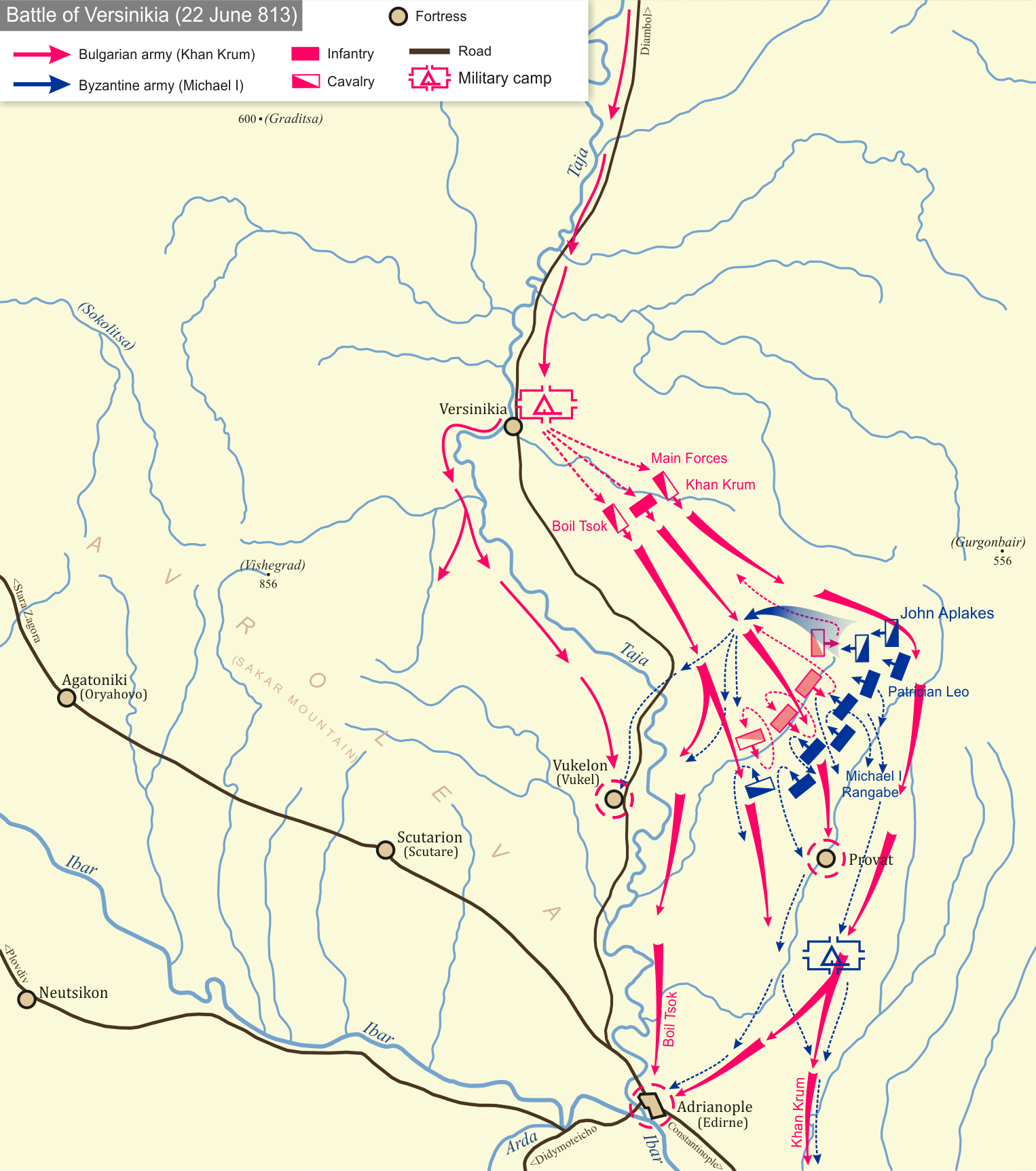813
Appearance
| Millennium: | 1st millennium |
|---|---|
| Centuries: | |
| Decades: | |
| Years: |
| 813 by topic |
|---|
| Leaders |
| Categories |
| Gregorian calendar | 813 DCCCXIII |
| Ab urbe condita | 1566 |
| Armenian calendar | 262 ԹՎ ՄԿԲ |
| Assyrian calendar | 5563 |
| Balinese saka calendar | 734–735 |
| Bengali calendar | 220 |
| Berber calendar | 1763 |
| Buddhist calendar | 1357 |
| Burmese calendar | 175 |
| Byzantine calendar | 6321–6322 |
| Chinese calendar | 壬辰年 (Water Dragon) 3510 or 3303 — to — 癸巳年 (Water Snake) 3511 or 3304 |
| Coptic calendar | 529–530 |
| Discordian calendar | 1979 |
| Ethiopian calendar | 805–806 |
| Hebrew calendar | 4573–4574 |
| Hindu calendars | |
| - Vikram Samvat | 869–870 |
| - Shaka Samvat | 734–735 |
| - Kali Yuga | 3913–3914 |
| Holocene calendar | 10813 |
| Iranian calendar | 191–192 |
| Islamic calendar | 197–198 |
| Japanese calendar | Kōnin 4 (弘仁4年) |
| Javanese calendar | 709–710 |
| Julian calendar | 813 DCCCXIII |
| Korean calendar | 3146 |
| Minguo calendar | 1099 before ROC 民前1099年 |
| Nanakshahi calendar | −655 |
| Seleucid era | 1124/1125 AG |
| Thai solar calendar | 1355–1356 |
| Tibetan calendar | 阳水龙年 (male Water-Dragon) 939 or 558 or −214 — to — 阴水蛇年 (female Water-Snake) 940 or 559 or −213 |

813 (DCCCXIII) was a common year starting on Saturday of the Julian calendar, the 813th year of the Common Era (CE) and Anno Domini (AD) designations, the 813th year of the 1st millennium, the 13th year of the 9th century, and the 4th year of the 810s decade. As of the start of 813, the Gregorian calendar was 4 days ahead of the Julian calendar, which was the dominant calendar of the time.
Events
By place
Byzantine Empire
- June 22 – Battle of Versinikia: The Bulgars, led by Krum, ruler (khan) of the Bulgarian Empire, defeat Emperor Michael I near Edirne (modern Turkey). The Byzantine army (26,000 men) is destroyed by a counter-attack of Bulgarian heavy cavalry, while trapped in the valley. Krum captures the Byzantine camp and a rich prize, including gold and weaponry.
- July 11 – Michael I, under threat by conspiracies, abdicates in favor of his general Leo the Armenian, and becomes a monk (under the name Athanasius). His sons are castrated to prevent them succeeding the Byzantine throne, and relegated into monasteries. One of them, Niketas (renamed Ignatius), eventually becomes a patriarch of Constantinople.
- July 17 – Krum reaches Constantinople, and sets his camp outside the walls. He is given an invitation, and a promise of safe conduct, to meet Leo V. Krum sets out unarmed for the capital with only a small escort, but is ambushed and manages to escape. After this unsuccessful Byzantine murder attempt, the Bulgars ravage much of Eastern Thrace.[1]
- Autumn – Siege of Adrianople: Krum captures Adrianople—one of the most important Byzantine fortresses in Thrace—after being attacked with siege engines. The garrison is forced to surrender, due to starvation. On the orders of Krum, the population of the surrounding area (numbering about 10,000) is transferred to Bulgarian territory, north of the Danube.[2]
- Ashot I ("the Great") becomes the first Georgian Bagratid prince of Iberia, under Byzantine protection.
Europe
- September 11 — Louis the Pious, king of Aquitaine (and only surviving legitimate son), is crowned co-emperor of the Franks, with his father Charlemagne.
- Danish Viking raiders, led by King Horik I, attack Vestfold (modern Norway), due to its insubordination (approximate date).
Abbasid Caliphate
- Autumn – Siege of Baghdad: Caliph al-Amin surrenders Baghdad, after Tahir ibn Husayn accepts his peace terms, but he is captured and executed. His brother al-Ma'mun becomes undisputed ruler of the Abbasid Caliphate.[3]
- The Baghdad School of Astronomy is opened by al-Ma'mun.[4]
- Caliph al Ma’mun founds a school in Baghdad called the House of Wisdom. In this school scholars translated Greek philosophy classics into Arabic.
By topic
Religion
- Third Council of Tours: Priests are ordered to preach in the vernacular (either Vulgar Latin or German).[5]
Births
- Fujiwara no Yoshimi, Japanese nobleman (d. 867)
- Fujiwara no Yoshisuke, Japanese statesman (d. 867)
- Li Rong, prince of the Tang Dynasty (or 812)
- Li Shangyin, Chinese official and poet (d. 858)
- Moses Bar-Kepha, Syriac bishop (approximate date)
- Muhammad at-Taqi, Muslim ninth Ismā'īlī imam (or 814)
- Theophilus, emperor of the Byzantine Empire (d. 842)
- Wandelbert, Benedictine monk (approximate date)
Deaths
- ’Abd Allah ibn Wahb, Muslim jurist (b. 743)
- Eanberht, bishop of Hexham (approximate date)
- Muhammad ibn Harun al-Amin, Muslim caliph (b. 787)
References
- ^ Fine, John V. A. Jr. (1991) [1983]. The Early Medieval Balkans: A Critical Survey from the Sixth to the Late Twelfth Century. Ann Arbor: University of Michigan Press. ISBN 0-472-08149-7.
- ^ Runciman, pp. 64–65[permanent dead link].
- ^ Fishbein (1992), pp. 197–202.
- ^ Owen Gingerich (1986). "Islamic Astronomy". Scientific American. 254 (4): 74–83. Bibcode:1986SciAm.254d..74G. doi:10.1038/scientificamerican0486-74. JSTOR 24975932.
- ^ Nadeau, Jean-Benoît and Barlow, Julie, The Story of French (Alfred A. Knopf 2006), p. 25.
